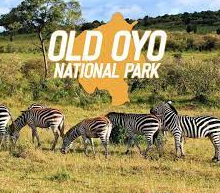
The Old Oyo National Park
The Old Oyo National Park, named after the old Oyo empire between the 16th and 18th centuries, is located about 51 kilometers north of Ibadan city. The park spans a remarkable 2,512 square kilometers; most of which fall in Oyo State, with a little extension to Kwara State.
The location has inevitably placed the park at a vantage position of abundance land area as well as diverse wildlife and cultural/historical settings.
The park is made up of two forest reserves – the Upper Ogun (1936) and Oyo-lle (1941) Forest Reserves. These forest reserves are unique ecosystems and historical relics that were converted to games reserves in 1952 and finally upgraded to the present status of a National Park.
Read Also: Akwa Ocha – The Symbol of Pride of Anioma Kingdom
The top attractions of the park which are of historical and archaeological value, are situated at the northern end of the park and these include the relics of the old city walls of Oyo-Ile, the great Agbaku cave which has evidence of the stone age, the “Kosomonu” hill, the old Akesan Market, Alaafin’s Palaces with crucibles of pottery used some centuries ago.
The rest of the park is a wildlife park covering many hectares of land and a campsite for tourists. Wildlife in the park include various species of elephants, buffalos, antelopes, baboons, Nile crocodiles, rock pythons and land tortoises.
The park has four types of vegetation which are dense woodland and forests outliers in the southeast part, mixed open savanna woodland in the central part, outcrop vegetation in the northeast and riparian grassland and fringing woodland occupying the forest plains and valleys along the Ogun River.
Outcrops of granite characterize the northeastern zone of the park, especially at Oyo-lle. The central part of the park has isolated hills and ridges of numerous rock outcrops. The extreme northern part on its own has caves as well as rock shelters dominating the axis.
The drainage system is also interesting as the park is well drained by rivers Ogun, Owu, Owe and their tributaries in the central and southern parts, while river Tessi drains the northeastern part of the park.
Fauna are found more abundantly in the southern part of the park which includes lion, western kob, roan antelope, western hartebeest, Grimm’s duiker, oribi, crested porcupine, anubis baboon, patas monkey, tantalus monkey and buffalo.
Others include red river hog, gaboon viper, spotted hyena, nile crocodile, rock python, land tortoise, waterbuck, bushbuck, warthog, guinea fowl, hammer kop, African fish eagle, bush fowl, Senegal parrot, grey heron, grey hornbill, white-headed plover, yellow mantled whydah etc.
There are more than 30 bird species recorded in the park. Some of the well known ones are Guinea Fowl, Hammer Kops, White headed Plover, African fish eagle (Cucumber vociferous), Yellow mantled Whydah (Euplectes spp), Bush fowl (Francolinus bicalcaratus), Senegal Fire-finch (Lagonostica senegalus), Grey Hornbill (Tockus nasitus) Grey Heron (Ardea cinerea) Bannerman’s Weaver (Ploceus bannermani) crossley’s Ground. Thrush (Zoothera crossleyi).
The administrative office of the park is located in Oyo Isokun area along Oyo-lseyin road, where necessary information and booking could be made.
Have you visited the Old Oyo National park before? Share your experience with us.
